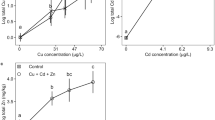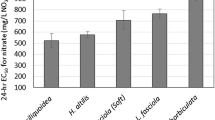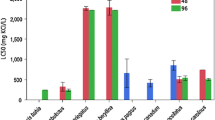Abstract
White sturgeon (Acipenser transmontanus) populations throughout western North America are in decline, likely as a result of overharvest, operation of dams, and agricultural and mineral extraction activities in their watersheds. Recruitment failure may reflect the loss of early-life stage fish in spawning areas of the upper Columbia River, which are contaminated with metals from effluents associated with mineral-extraction activities. Early-life stage white sturgeon (A. transmontanus) from the Columbia River and Kootenai River populations were exposed to copper during 96-h flow-through toxicity tests to determine their sensitivity to the metal. Similar tests were conducted with rainbow trout (RBT [Oncorhynchus mykiss]) to assess the comparative sensitivity of this species as a surrogate for white sturgeon. Exposures were conducted with a water quality pH 8.1–8.3, hardness 81–119 mg/L as CaCO2, and dissolved organic carbon 0.2–0.4 mg/L. At approximately 30 days posthatch (dph), sturgeon were highly sensitive to copper with median lethal concentration (LC50) values ranging from 4.1 to 6.8 μg/L compared with 36.5 μg/L for 30 dph RBT. White sturgeon at 123–167 dph were less sensitive to copper with LC50 values ranging from 103.7 to 268.9 μg/L. RBT trout, however, remained more sensitive to copper at 160 dph with an LC50 value of 30.9 μg/L. The results indicate that high sensitivity to copper in early-life stage white sturgeon may be a factor in recruitment failure occurring in the upper Columbia and Kootenai rivers. When site-specific water-quality criteria were estimated using the biotic ligand model (BLM), derived values were not protective of early-life stage fish, nor were estimates derived by water-hardness adjustment.
Similar content being viewed by others
References
American Public Health Association (2005) American Water Works Association and Water Pollution Control Federation. Standard methods for the examination of water and wastewater. Method 4500-CLG for drinking water, 17th edn. APHA, Washington, DC
American Society for Testing and Materials (2006) ASTM guide E 729–96 (2002) Standard guide for conducting acute toxicity tests with fishes, macroinvertebrates, and amphibians. In: Annual book of ASTM standards, vol 11.06. ASTM, West Conshohocken, PA, pp 66-87
Benoit DA, Pugliski FA (1973) A simplified flow-splitting chamber and siphon for proportional diluters. Water Res 7:1915–1916
Benson WH, Birge WJ (1985) Heavy metal tolerance and metallothionein induction in fathead minnows: results from field and laboratory investigations. Environ Toxicol Chem 4:209–217
Bodek I, Lyman WJ, Reehl WF, Rosenblatt DH (1988) Environmental inorganic chemistry: properties, processes, and estimation methods. Pergamon, New York
Bortleson GC, Cox SE, Munn MD, Schumaker RJ, Block EK (2001) Sediment-quality assessment of Franklin D. Roosevelt Lake and the upstream reach of the Columbia River, Washington, 1992. Water Supply Paper No. 2496. United States Geological Survey, Reston, VA
Brinkmann T, Sartorius D, Frimmel FH (2003) Photobleaching of humic rich dissolved organic matter. Aquat Sci 65:415–424
Brumbaugh WG, May TW, Besser JM, Allert AL, Schmitt CJ (2007) Assessment of elemental concentrations in streams of the New Lead Belt in southeastern Missouri, 2002-05. United States Geological Survey Scientific Investigations Report 2007-5057. http://pubs.usgs.gov/sir/2007/5057/. Accessed 14 May 2009
Buchwalter DB, Linder G, Curtis LR (1996) Modulation of cupric ion activity by pH and fulvic acid as determinants of toxicity in Xenopus laevis embryos and larvae. Environ Toxicol Chem 15:568–573
Clearwater SJ, Farag AM, Meyer JS (2002) Bioavailability and toxicity of diet-borne copper and zinc to fish. Comp Biochem Physiol C Pharmacol Toxicol Endocrinol 132:269–313
Conte FS, Doroshov SI, Lutes PB, Strange EM (1988) Hatchery manual for the white sturgeon (Acipenser transmontanus Richardson). Division of Agriculture and Natural Resources, University of California, Oakland
DeSchamphelaere KC, Janssen CR (2002) A biotic ligand model predicting acute copper toxicity for Daphnia magna: the effects of calcium, magnesium, sodium, potassium, and pH. Environ Sci Technol 36:48–54
Diamond JM, Bressler DW, Serveiss VB (2002) Assessing relationships between human land uses and the decline of native mussels, fish, and macroinvertebrates in the Clinch and Powell River watershed, USA. Environ Toxicol Chem 21:1147–1155
DiToro DM, Allen HE, Bergman HL, Meyer JS, Paquin PR, Santore RC (2001) Biotic ligand model of the acute toxicity of metals. 1 Technical basis. Environ Toxicol Chem 20:2383–2396
Dwyer JF, Mayer FL Jr, Sappington LC, Buckler DR, Bridges CM, Greer IE et al (2005) Assessing contaminant sensitivity of endangered and threatened aquatic species: part I. Acute toxicity of five chemicals. Arch Environ Contam Toxicol 48:143–154
Erickson RJ, Bills TD, Clark JR, Hansen DJ, Knezovich JP, Mayer FL Jr et al (1994) Synopsis of discussion session on physicochemical factors affecting toxicity. In: Hamelink JL, Landrum PF, Bergman HL, Benson WH (eds) Bioavailability: physical, chemical, and biological interactions. Lewis, Boca Raton, pp 31–38
Erickson RJ, Benoit DA, Mattson VR, Nelson HP, Leonard EN (1996) The effects of water chemistry on the toxicity of copper to fathead minnows. Environ Toxicol Chem 15:181–193
Evans DH (1987) The fish gill: site of action and model for toxic effects of environmental pollutants. Environ Health Perspect 71:47–58
Finney DJ (1952) Probit analysis, 2nd edn. Cambridge University Press, Cambridge
Grosell M, Wood CM (2002) Copper uptake across rainbow trout gills: mechanisms of apical entry. J Exp Biol 205:118–1179
Handy RD, Eddy FB, Baines H (2002) Sodium-dependent copper uptake across epithelia: a review of rationale with experimental evidence from gill and intestine. Biochim Biophys Acta 1566(2002):104–115
Hildebrand L, Birch G (1996) Canadian Columbia River white sturgeon stock stabilization discussion document. Report to B.C. Ministry of Environment, Lands and Parks
Hildebrand L, McLeod C, McKenzie S (1999) Status and management of white sturgeon in the Columbia River in British Columbia, Canada: an overview. J Appl Ichthyol 15:164–172
Hodson PV (1988) The effect of metal metabolism on uptake, disposition and toxicity in fish. Aquat Toxicol 11:3–18
Howell MD, McLellan JG (2005) Lake Roosevelt white sturgeon recovery project annual progress report January 2003–March 2004. United States Department of Energy, Bonneville Power Administration, Portland
Hughes GM (1984) General anatomy of the gills. In: Hoar WS, Randall DJ (eds) Fish physiology, vol 10A. Academic, Orlando, pp 1–72
HydroQual (2007) The biotic ligand model Windows interface, version 2.2.3: user’s guide and reference manual. HydroQual, Mahwah
Ireland SC, Beamesderfer RCP, Paragamian VL, Wakkinen VD, Siplel JT (2002) Success of hatchery-reared juvenile white sturgeon (Acipenser transmontanus) following release in the Kootenai River, Idaho, USA. J Appl Ichthyol 18:642–650
May TW, Wiedmeyer RH, Brumbaugh WG, Schmitt CJ (1997) The determination of metals in sediment pore waters and in 1 N HCl-extracted sediments using ICP-MS. Atomic Spectr 18:133–139
McKim JM, Erickson RJ (1991) Environmental impacts on the physiological mechanisms controlling xenobiotic transfer across fish gills. Physiol Zool 64:39–67
Mebane CA, Dillon FS, Hennessy DR (2012) Acute toxicity of cadmium, lead, zinc, and their mixtures to stream-resident fish and invertebrates. Environ Toxicol Chem 31:1334–1348
Meyer JS, Adams EJ, Brix KV, Luoma SN, Mount DR, Stubblefield WA et al (eds) (2005) Toxicity of diet borne metals to aquatic organisms. SETAC Press, Pensacola
Meyer JS, Adams WJ, DeForest DK, Dwyer RL, Gensemer RW, Gorsuch JW et al (2012) Water chemistry matters in metal-toxicity papers [letter to the editor]. Environ Toxicol Chem 31:689–690
Mount DI, Brungs WA (1967) A simplified dosing apparatus for fish toxicological studies. Water Res 1:21–29
National Academies of Science (1993) Nutrient requirements of fish. Subcommittee on Fish Nutrition, National Research Council National Academy Press, Washington, DC
Niyogi S, Wood CM (2004) Biotic ligand model, a flexible tool for developing site-specific water quality guidelines for metals. Environ Sci Technol 38:6177–6192
Paragamian VL, Beamesderfer RC, Ireland SC (2005) Status, population dynamics, and future prospects of the endangered Kootenai River white sturgeon population with and without hatchery intervention. Trans Am Fish Soc 134:518–532
Paulson AJ, Cox SE (2007) Release of elements to natural water from sediments of Lake Roosevelt, Washington, USA. Environ Toxicol Chem 26:2550–2559
Piper RG, McElwain IB, Orme LE, McCraren JP, Fowler LG, Leonard JR (1982) Fish hatchery management. United States Department of the Interior, Fish and Wildlife Service, Washington DC
Playle RC (1998) Modeling metal interactions at fish gills. Sci Total Environ 219:147–163
Playle RC, Dixon DG, Burnison BK (1993) Copper and cadmium binding in fish gills: modification by dissolved organic carbon and synthetic ligands. Can J Fish Aquat Sci 50:2667–2677
Randall D, Lin H, Wright PA (1991) Gill water flow and the chemistry of the boundary layer. Physiol Zool 64:26–38
Santore RC, Paquin PR, DiToro DM, Allen HE, Meyer JS (2001) Biotic ligand model of the acute toxicity of metals. 2. Application to acute copper toxicity in freshwater fish and Daphnia. Environ Toxicol Chem 20:2397–2402
Schenker N, Gentleman JF (2001) On judging the significance of differences by examining the overlap between confidence intervals. Am Stat 55:182–186
Schindler DW, Curtis PJ, Parker BR, Stainton MP (1996) Consequences of climate warming and lake acidification for UV-B penetration in North American boreal lakes. Nature 379:705–708
Sellin MK, Tate-Boldt E, Kolok AS (2005) Acclimation to Cu in fathead minnows: does age influence the response? Aquat Toxicol 74:97–109
Snyder EB, Minshall GW (2005) An energy budget for the Kootenai River, Idaho (USA) with application for management of the Kootenai white sturgeon Acipenser transmontainus. Aquat Sci 67:433–472
Stephan CE, Mount DI, Hansen DJ, Gentile JR, Chapman GA, Brungs WA (1985) Guidelines for deriving numerical national water quality criteria for the protection of aquatic organisms and their uses. Office of Research and Development, Environmental Research Laboratories, Duluth, MN; Narragansett, RI; Corvallis, OR
Stumm W, Morgan JJ (1981) Aquatic chemistry: an introduction emphasizing chemical equilibria in natural waters. Wiley, New York
Tao S, Long A, Liu C, Dawson R (2000) The influence of mucus on copper speciation in the gill microenvironment of carp (Cyprinus carpio). Ecotoxicol Environ Saf 47:59–64
UCRESIR (2003) Upper Columbia River expanded site inspection report northeast Washington, TDD: 01-02-0028. USEPA region 10, START-2, Superfund Technical Assessment and Response Team. USEPA, Seattle, WA
UCWSRI (2002) Upper Columbia White Sturgeon Recovery Initiative. http://uppercolumbiasturgeon.org/RecoveryEfforts/RecoveryPlan.pdf. Accessed on 3 March 2011
United States Environmental Protection Agency (1983) Methods for chemical analysis of water and wastes. Method 415.1. EPA-600/4-79-020. USEPA, Washington, DC
United States Environmental Protection Agency (1986) Quality criteria for water 1986. EPA 440/5-86-001. Office of Water, Regulation and Standards, Washington, DC
United States Environmental Protection Agency (2001) Method 200.7—Trace elements in water, solids, and biosolids by inductively coupled plasma-atomic emission spectrometry. EPA-821-R-01-010. USEPA, Washington, DC
United States Environmental Protection Agency (2003) Draft update of ambient water quality criteria for copper. EPA 822-R-03-026
United States Environmental Protection Agency (2006) National recommended water quality criteria. USEPA, Washington, DC
United States Environmental Protection Agency (2007a) Aquatic life ambient freshwater quality criteria—Copper. 2007 revision (amended version as of March 2, 2007). USEPA, EPA-822-R-07-001. USEPA, Washington, DC. http://www.epa.gov/waterscience/criteria/copper/. Accessed 7 May 2012
United States Environmental Protection Agency (2007b) Method 9056a—Determination of inorganic anions by ion chromatography. http://www.epa.gov/wastes/hazard/testmethods/sw846/pdfs/9056a.pdf. Accessed 7 May 2012
United States Fish and Wildlife Service (2006, February 18) Fish and wildlife service biological opinion regarding the effects of Libby dam operations on the Kootenai River white sturgeon, bull trout and Kootenai sturgeon critical habitat. 1-9-01-F-0279R
Wang N, Mebane CA, Kunz JL, Ingersoll CG, May TW, Arnold WR et al (2009) Evaluation of acute copper toxicity in juvenile freshwater mussels (fatmucker, Lampsilis siliquoidea) in natural and reconstituted waters. Environ Toxicol Chem 28:2367–2377
Wang N, Mebane CA, Kunz JL, Ingersoll CG, Brumbaugh WG, Santore RC et al (2011) Influence of dissolved organic carbon on toxicity of copper to unionid mussel (Villosa iris) and a chladoceran (Ceriodaphnia dubia) in acute and chronic water exposures. Environ Toxicol Chem 30:2115–2125
Washington State Department of Ecology (2006) Water quality standards for surface waters of the State of Washington. Chapter 173-201A WAC. Amended November 20, 2006. Washington State Department of Ecology, Olympia, WA
Welsh PG, Lipton J, Mebane CA, Marr CD (2008) Influence of flow-through and renewed exposures on the toxicity of copper to rainbow trout. Ecotoxicol Environ Safety 69:199–208
Williamson CE, Hargreaves BR, Orr PS, Lovera PA (1999) Does UV play a role in changes in predation and zooplankton community structure in acidified lakes? Limnol Oceanogr 44:774–783
Acknowledgments
We thank Lynne Johnson and Steve Olson for dissolved organic carbon analysis; Bill Brumbaugh for copper, anion, and cation ion analyses; Chris Mebane for BLM calculations; and Ning Wang and Bill Brumbaugh for early reviews.
Disclaimer
Any mention of trade, firm, or product names is for description purposes only and does not imply endorsement by the U.S. Government.
Author information
Authors and Affiliations
Corresponding author
Rights and permissions
About this article
Cite this article
Little, E.E., Calfee, R.D. & Linder, G. Toxicity of Copper to Early-life Stage Kootenai River White Sturgeon, Columbia River White Sturgeon, and Rainbow Trout. Arch Environ Contam Toxicol 63, 400–408 (2012). https://doi.org/10.1007/s00244-012-9782-3
Received:
Accepted:
Published:
Issue Date:
DOI: https://doi.org/10.1007/s00244-012-9782-3




